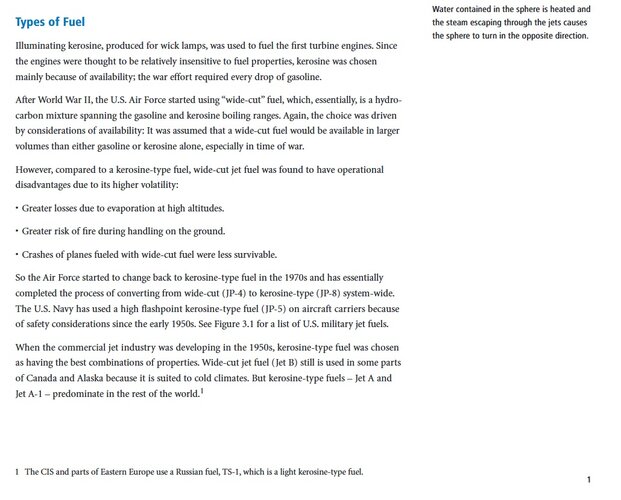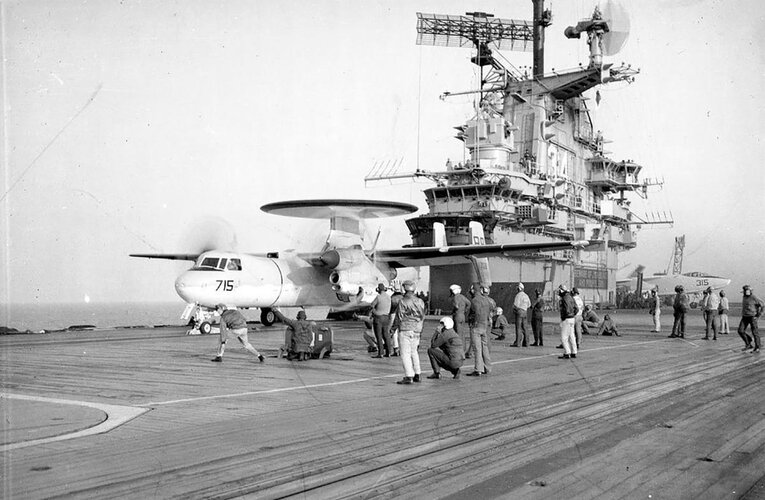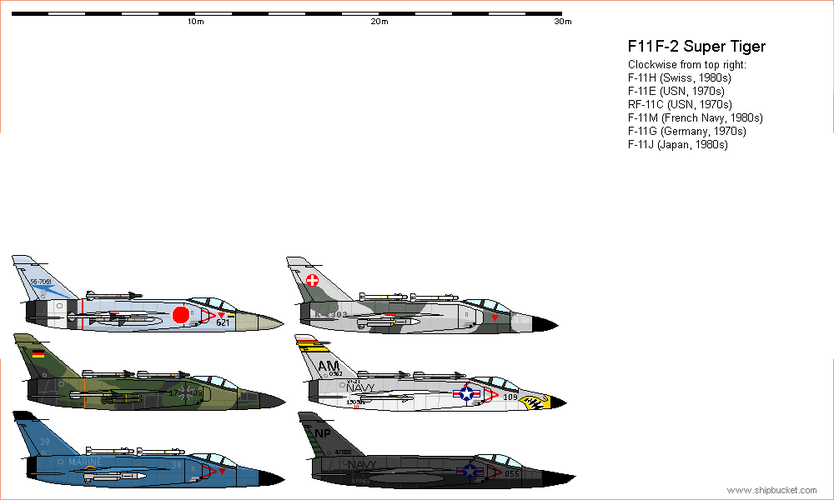My apologies for the long post, binged the thread.
IF this alternate Tiger can live long enough for some bright lad to notice that the TF-41 is within an inch and 50 pounds of the dimensions of the J-65 then we are in business!
15,000 pounds of thrust for 30 minutes at an SFC of .664 as opposed to that same thrust on AB and an SFC IIRC of 1.9 on the J-79. Sure it would come at the cost of the same kind of performance hits the F-4k had in comparison to the standard F-4, because of the bigger intakes, but still...
Yeah, a Spey Supertiger would be absolutely NUTS!
EDIT.. doing some quick math a hypothetical 27.5 version fitted with an F-404 sometime in the late 70's should have a range as above of about 1560 and an endurance of 2 hours and 10 minutes. She would also be about 1400 pounds lighter if the weight I have for the F-404 is correct, putting her at unity under AB.
That will get into some serious ballasting to keep CG in place. I don't think you'd save a whole lot of weight there.
Never thought before that raising the nose with an extended nose wheel strut could cut so much launching speed out of a naval fighter. That explains why the Etendard IVM nose was perched so high. I suppose the most important word is "incidence" as in "Crusader variable incidence wing". "Varied incidence nosewheel strut" - VINS
Yep! Even the little Cessnas have ground-adjustable incidence wings: the rear spar is held onto the airframe with a 5" or so diameter bushing that has one bolt through it (4 bolts total per wing, leading and trailing spars, plus each end of the strut). You usually attach the wings so that the bolt is at the 3 oclock or 9 oclock position, and can tweak until the pilot likes how it flies.
That 133 MPH is minimum safe approach speed.. power on STALL was 105. I listed it and the adjustments for additional wing area in the first post... it does get potentially dicey at some weights on the CVS but it is worth it to have a higher performance all weather fighter on it. Might actually push the USN to do a turboprop conversion on the S2/E1's so you could get a tanker function or just launch at a slightly lower fuel state to give some margin.
One thing that has confused me for a long time is why the USN didn't do a turboprop conversion on the S2/E1/C1s. What else on the CVS was still using AVGAS?
Not sure if this is the right place to pose this question, but it seems to fit.
Why do the US and UK navies go for ever larger aircraft in this period when it is clear that smaller aircraft would be easier to use even on the Forrestals.
We seem to have reversed the process since the 80s with F14 giving way to F18 and then to F35.
The paper exercise here with SuperTiger suggests there were other options.
The electronics was a big driver of size. Vacuum tube electronics are huge and heavy. Then you need more range, because the Soviets have 300+km range missiles to deal with...
Also, remember that the F18 is a replacement for the F4, not the Tomcat.
APQ-72 in its earliest form was 24 inch too so it would fit in the nose of the Cru III. For this thread and the RN using the aircraft the possibility of the 18 inch AI.23 leaves open the question of staying with the 18 inch dish allowing a greater range of motion for the dish or upgrading to 24 with the same range of motion... the additional volume would allow for tacking on electronics needed for Sparrow usage on the AI.23 central core in either case.
I'd go for the bigger dish, for more radar range. That makes the dish have 78% more area.
I wish I had more information on what they in the AN-1 project to this aircraft.. the way they folded her up was like origami!
I strongly suspect that they went with the old Gumman Sto-wing that twists and folds.
Ya know, since we're talking about trying to short circuit the weight spiral, what about removing the guns? The 20mm Colt Mk12 weighed 101.4 pounds. And the Tiger had 4 of them. Per the SAC sheet, it also had 500 rounds of 20mm ammo. The only thing it doesn't state is whether it was 500 rounds per gun or total. Assuming it was 500 rounds total with each gun having 125 rounds each, you're saving a minimum of 527 pounds out of the airframe (not including the mounting hardware for the guns and ammunition stowage). That's a pretty significant savings. And once you include all the associated equipment, you're looking at close to a 550 pound savings. You can also subtract the weight of the AN/APG-30 (or AN/APS-67) from the aircraft. That will at least help offset some of the added weight from replacing the gun radar with something like the AN/APQ-83 or -84. Given you're trying to make this a light carrier capable aircraft, you don't need the AN/APQ-72 and Sparrows. You need a basic search radar and Sidewinders. That's much more doable than trying to finagle a "Phantom-Lite" into an airframe as maxed out as the Tiger's is
No, the lesson of Vietnam is to NEVER remove guns. Might drop down to a pair of DEFA/ADEN 30mm instead of the crappy Colt 20mm, but that won't save you much weight. A DEFA 30mm weighs in at about 190lbs/gun and the ammunition is heavier than the 20x110mm.
Another light fighter possibility for the RN if it had relaxed its requirements and gone for
numbers rather than capability can be found here:
That's a
very false economy.
We can argue for a Twosader or Super Twoger with APQ-72 and 4x Sparrows with 4x Sidewinders, which will generally outperform the F-4 while being much lighter and cheaper to operate (one engine means half the fuel burned and half the maintenance).
But you're not going to chase the Bears away with some Sidewinders.
and some of that weight is in the WTF category of changes/amendments to the aircraft we have no information on.. and some of them look to be more fuel.. which is super curious to me since the J-79 was 250 pounds lighter than the J-65. As I recall I don't remember Corky mentioning any frame strengthening
I agree with
@H_K 's analysis:
My read is the basic Super Tiger conversion (98J-1) added ~400lbs, the multirole 98J-5 added another ~800lbs, and the all-weather 98J-2 with Sparrow added another ~800lbs.
The 400lbs for the 98J-1 probably came from all the small airframe changes to optimize for supersonic flight (e.g. longer tailcone, added wing blivets, dorsal launcher for Aim-9s etc) even if the J79 engine itself was 250lbs lighter.
The 800lbs for the J-5 probably came mostly from strengthening and adding air-to-ground capability (including 2 new wing pylons and heavier drop tanks), as the original F11F didn’t have a very strong airframe (6.5g load factor and low max. landing weight). Plus further aerodynamic refinements (larger nose & canopy), more avionics compared to the very basic F11F (APQ-50 radar, improved navigation, radios etc).
The 800lbs for the J-2 probably was mostly avionics, including ~250lbs for Sparrow III capability, plus some more for an improved electrical system etc.
Agreed, that's likely what happened. Each change sounds about right in terms of weight.
Assuming that’s old JP4 fuel @ 6.5lbs/gal so add ~4.5% for JP5 @ 6.8lbs/gal, which gives you 10,240lbs… close enough.
When did the USN change from JP4 to JP5? After the Forrest Fire?




